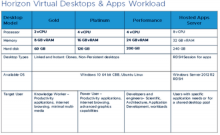by: VMware Sr. Manager, Client Engineering Aju Sukumaran
Today, delivering ideal colleague (end user) experiences is more complicated and fraught with error potential than ever before, and that puts virtual desktop administrators in a tough position.

VDI administrators have a lot of manage, and worry about
That’s why VMware IT developed a variety of protocols and technologies designed to ensure everyone is happy. It starts with a five-pronged, colleague-centric approach that involves our engineers empathizing with colleague concerns/requests/demands, defining the problem, ideating a solution, prototyping that solution, and ultimately testing/deploying the final product.
These phases revolve around some basic requirements:
- All applications and the colleague’s desktop are recommended to be in the same location for the best experience.
- Colleagues must have ability to bookmark applications (versus a forced search each time).
- Colleagues must have easy access via a single sign-on (SSO) for any and all devices used—no more frustrating passwords or URLs to remember.
The magic behind the happiness

A snapshot of the underlying VDI
From a pure technology standpoint, a lot goes on behind the scenes to deliver the best experiences. Colleague desktop and ‘my documents’ data is redirected to a file share, and colleagues are instructed to utilize a central repository system to save all files. This provides them with the flexibility to move around different VMware Horizon® 7 pods (different cloud groups—see below) available internally, eliminating any dropped connections or access issues.
The Horizon app, available in Windows and non-Windows devices, offers simplified access to applications such as Microsoft Office, Visio, and Project directly from VMware Workspace ONE®.

A hybrid cloud strategy expands colleague access to virtual desktops found in Horizon Cloud on Microsoft Azure, IBM SoftLayer, and AWS (VMware vCloud® on AWS). Colleagues can choose their best-fit virtual desktop based on their individual requirements. In addition, this new approach allows IT admin to use the cloud control plane to manage the multiple instances from single control plane, a significant benefit.

All Windows OS upgrades are conducted in accordance with Microsoft releases, and employ an N-1 approach for productions. Application lifecycle management, achieved using App Volumes, has been streamlined and improved—colleagues never endure any downtime for an app update or similar upgrades. User Environment Management (UEM) software provides simplified management of the user environment variables and application configurations.
Provisioning/deprovisioning is much easier, and appstacks are created based on business units, licensed applications, and individual application stacks. A persistent colleague experience is enabled using stateless virtual desktops running on a high performance SDDC stack.
Performance optimization tools include View Planner for load testing and to simulate deployment scenarios. VMware vRealize® Operations™ for capacity planning and health monitoring of Horizon stacks. Various utilities found in labs.vmware.com depending on scenario. And select third-party tools employed to obtain objective benchmarks for performance, login times, boot times, and similar.
For Windows 10 migration, VDI admins should keep in mind the following best practices discovered through our own trial and error.

Trouble in paradise? Not so much
The most commonly colleague-reported issues with this approach include the inability to log in, inability to save files as disk space is full, applications not loading/not seen, frequent system disconnects, slow desktop/system speed, and similar. Thankfully, the combination of cloud, automation, machine learning, and other advanced technologies have made it faster and simpler to pinpoint specific issues and find resolutions. Automation acts as a ‘first responder’, delivering probable sources of the problem and/or indicating possible human error. From there, the admin can then easily troubleshoot the issue by asking specific questions to discover the problem’s source.
Thanks to all these initiatives and technology, VDI admins can enjoy a symbiotic (versus adversarial) relationship with colleagues in every location, one that significantly benefits all parties involved.
VMware on VMware blogs are written by IT subject matter experts sharing stories about our digital transformation using VMware products and services in a global production environment. Contact your sales rep or vmwonvmw@vmware.com to schedule a briefing on this topic. Visit the VMware on VMware microsite and follow us on Twitter.



